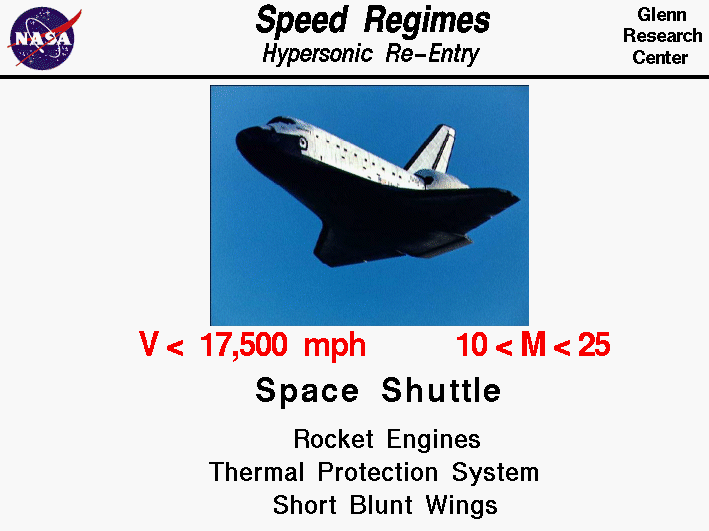
As an aircraft moves through the air, the air molecules near the
aircraft are disturbed and move around the aircraft.
Exactly how the air re-acts to the aircraft depends upon the
ratio of the speed of the aircraft to the
speed of sound through the air.
Because of the
importance of this speed ratio, aerodynamicists have designated it
with a special parameter called the
Mach number
in honor of Ernst Mach, a late 19th century physicist who studied gas
dynamics.
As a spacecraft re-enters the earth's atmosphere, it is
traveling very much faster than the speed of sound.
The aircraft is said to be hypersonic.
Typical low earth orbit re-entry speeds are near 17,500 mph
and the Mach number M is nearly twenty five,
M < 25.
The chief characteristic of re-entry aerodynamics is that the
temperature
of the flow is so great that the chemical bonds of the
diatomic molecules of the
air
are broken. The molecules
break apart producing an electrically charged plasma around the
aircraft. The
air density
is very low because re-entry occurs many miles above the
earth's surface.
Strong
shock waves
are generated on the lower surface of the spacecraft.
The only manned aircraft to currently fly in this regime are the
American Space Shuttle, the Russian Soyuz spacecraft, and the
Chinese Shenzhou spacecraft. The figure shows the Shuttle
after it has passed through the re-entry regime.
The Shuttle uses a
rocket
propulsion system to get into orbit, but during re-entry
the aircraft is actually an un-powered glider.
Small steering rockets are used
for maneuvering early in the re-entry
because the low density of the air
at altitudes above 50 miles makes aerodynamic surfaces
ineffective.
The heat is so great during re-entry that a special
thermal protection system
is used to keep the spacecraft intact. On the Shuttle,
special silicon tiles are placed on the aluminum skin
to insulate the skin. On the leading edge of the wings,
carbon-cabon composite material is used to withstand
the heat. The high forces and high heat dictate
that the Shuttle has short, blunt wings.
The Shuttle flies at a high
angle of attack
during re-entry to generate drag to dissipate speed.
It executes hypersonic "S-turn" maneuvers to kill
off speed during re-entry. The
lift
of the wings is only important in the final flare maneuver
at touchdown.
The Soyuz, Shenzhou, and all of the early Apollo, Gemini, and
Mercury spacecraft used a thermal protection system that is
different than the Space Shuttle. Each of these spacecraft use
an ablative, or "burning", heat shield. The
heat shield is made of special ceramic materials and is
designed to slowly burn away as it encounters the high temperature
plasma flow aft of the bow
shock wave.
The change of phase from solid to liquid to gas and the
convection
of the flow away from the spacecraft help to protect the astronauts
from the heat of re-entry.
Activities:
Guided Tours
Navigation ..




- Beginner's Guide Home Page
|
